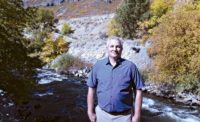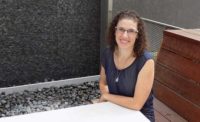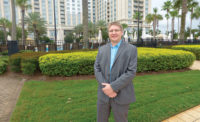Shawn MacLean Wilson, P.E., was in the midst of packing up her belongings in San Diego and making the move north to San Francisco to join Interface Engineering. She was ready for the next step in her career and got a warm vote of confidence from her mentor, the late Steve Weeks.
“He was a huge influence on me and my perception of how to be an engineer,” Wilson recalls. “I remember when I left, he called me and said, ‘You know…I just want you to know that you’re one of the good ones.’
“I always appreciated him calling me to tell me that. I always had looked up to him and any time I had an engineering question I would go to him. I’d think, ‘I hope Steve doesn’t think I’m crazy.’ And he always said, ‘No, no, you’re on the right track. You’re doing great.’”
That right track led her up the ranks at Interface to her current role as an associate principal and senior mechanical engineer. She has played a major role in making Interface an industry leader in energy-efficient designs by developing forward-thinking projects across the United States. With all that in tow, including a deep respect among industry members, Wilson is pme’s 2016 Mechanical Engineer of the Year.
Perfect match
When Wilson arrived on the Cal Poly campus in San Luis Obispo, Calif., she brought her love of math and science with her – as well as 18 years of experience taking apart and putting back together household items. Wilson had to pick a major quickly and after talking with the mechanical engineering group, she came aboard.
“It intrigued me a little more (than other disciplines) because I felt there was more because I’m dealing with different systems,” she says. “It sounded like more of a challenge and I gravitated toward that. It fit my personality better.”
Cal Poly provided “a hands-on” learning experience, according to Wilson, and after graduation she started her career working in the bullpen at a firm in San Diego. She stayed there for nine years, but had bigger goals to achieve as well as a desire to be closer to her San Francisco home region.
“I got to a point in my career where I was sort of at a crossroads,” Wilson recalls. “I needed to decide what I wanted out of my career. I did research on companies up here because I honestly knew nothing about the market here since I had been pretty much only working on projects in San Diego and Southern California.”
After her research and speaking with friends in the area, Wilson and Interface Engineering became a natural fit.
“Interface sounded like it would be the best for me when I talked to them because they were growing,” she says. “I liked the idea of coming to a firm that was on the rise.”
Saving resources
Another reason Wilson felt at home with Interface Engineering is because the company designs sustainable systems. Wilson has designed projects for almost every market sector and has made cutting-edge design a priority.
“We look at doing a lot of things that are pushing toward net zero. We do a lot of projects looking at living-building challenges and obviously, LEED,” she says.
To be at the forefront of sustainable design, Wilson needs clients and industry partners to collaborate with on a regular basis. One critical partnership Wilson and Interface Engineering have developed is with local architecture firm WRNS Studios. Mitch Fine, a founding partner of the architecture firm, is in awe of Wilson’s work ethic.
“Shawn is relentless in her desire to service her projects,” he says. “She is extremely dedicated and it seems like she never stops working. She has earned the trust of the leadership structure at my firm and she holds her own with the sub-trades and subcontractors. She always knows everything about the project and never has to say, ‘Let me get back to you.’”
Currently, Wilson and Fine are developing San Francisco State University’s Mashouf Wellness Center that is scheduled to open in the first quarter of 2017. The 118,700-sq.-ft.-facility is designed to reach LEED Platinum, one of a handful of recreation centers to earn that designation in the United States, according to Wilson.
“The big thing we’re doing is we’re taking advantage of the temperate climate by using natural ventilation for the whole project,” Wilson states. “It’s 100% outside air all the time.”
Another major obstacle Wilson had to overcome was the air quality within the wellness center. Wilson designed a single-pass air system for the building that will work swimmingly for the facility.
“The single-pass air system is important from my perspective, so the air quality in the pool is as high as possible,” she states. “However, we’re basically throwing away all this heat that we’ve already put into the system, so I added a runaround coil in the air-handling unit that would preheat the outside air coming into it and maximize energy recovery.
“By doing that I was able to significantly decrease the size of the chiller I had for the dehumidification. It also limited the scope of the hot water required for heating the space. It’s a tremendous amount of energy to waste because with a pool you have to maintain the air temperature at 2° F above the temperature of the surface to prevent evaporation.”
A sustainable project such as the wellness center allows for the corporate priorities of WRNS Studios and Interface Engineering to perfectly align. Both companies want to be leaders in sustainable designs, especially in California where drought conditions and state-required efficiencies must be met or exceeded.
“They’re always on the leading edge of that conversation,” Fine says. “The codes (in California) already are stringent. The default with our clients right now is already as soon as you get a project from WRNS, it’s going to be a building with a strong eye toward sustainability. And that’s why Interface is our consultant on many of these projects.”
Fine wishes every consultant that he and WRNS works with conducted themselves the way Wilson does, but she is a cut above everyone else, he explains.
“There is nothing she does not know about the project she is managing,” Fine says. “Her ability to be as responsive as she is elevates the thinking at our firm. They make us look good. It is harder and harder to win work these days. One of the ways we do it is by presenting a unified team. We present engineers we’ve worked with and trust. Shawn is such an integral piece of that. It’s to the point that when I’m chasing a project, my default is to go with Interface because they have people such as Shawn that have proven themselves to us.”
Developing trends
When Wilson started her engineering career she did not know what a variable refrigerant flow system was. Today, Wilson can’t believe the trend she sees in how many VRF systems she’s designing. She notes the VRF systems started in the education sector and have continued to grow.
“It has blown up and it’s been a cost-effective solution,” she notes. “I’ve been doing it in high-rise residential projects as well as commercial developments. If you’re a developer, you want to get the base building cost down and then find tenants that can come in and plug and play into their building. It’s a great system that doesn’t take up a lot of space. It’s quiet and it’s simple to operate. It sounds complicated because if you’ve never done it, it might sound a little intimidating, but it’s been a great technology. I’ve used it tremendously.”
Wilson says the VRF technology continues to expand especially because it can be used with hydronic heat exchangers.
“If you need hot water or chilled water for something, you can take advantage of the heat-recovering aspect of the VRF system,” she says. “It can be used for preheating domestic water or heat and vent units or something that needs it.”
Today, Wilson’s clients desire buildings that make their occupants feel more comfortable and have elements where the building is more self-sustained. One project she’s designing for a major computer company features an air-cooled heat-recovery system for providing chilled water and heating water. Wilson designed the system to have a thermal chilled water-storage system used to offset peak loads and reduce energy costs. It also reduces the size of the central plant and lowers the equipment costs. There are radiant floor and ceiling panels throughout the entire 600,000-sq.-ft., two-story facility and a large green roof employees can use as an active environment.
“It’s challenging finding ways to efficiently run systems because one of the issues when you have a big horizontal place is you’re running a lot of utilities,” she says. “The other challenge was how do you hide all these things effectively because the architect, of course, is trying to make it pretty.”
What’s next?
At Interface Engineering, Wilson and the team continually are thinking about how to get more out of their designs. One way they accomplish that is by thinking about the buildings’ “whole water story,” she states. Since California is struggling with drought conditions and natural resources, Wilson looks for strategies that either will eliminate mechanical makeup water completely or ways to recover it, such as from condensate.
“In San Francisco you’re required, depending on the size of the building and where it’s located, to have a greywater system onsite,” she notes.
Wilson says air-cooled systems is another area where efficiency can be found. She adds the technology has evolved so much that it is to the point where energy efficiency is getting close to a water-cooled system, especially when employing strategies such as thermal storage and radiant systems.
“It starts to make a lot more sense, especially if you’re operating at temperatures where they are most efficient,” she says. “The air-cooled VRF systems, air-cooled heat-pump recovery systems, heat-recovery chillers and things such as that from a central plant perspective have helped to eliminate natural gas use as well.”
Taking charge
Hormoz Janssens, P.E., and the managing principal at Interface Engineering, brought Wilson to the company nearly five years ago. Wilson’s technical ability was a major factor in her getting a senior mechanical engineer position with Interface, but it was her dedication and hard work that made her an associate principal before the age of 40, Janssens reveals. The next major hurdle for Wilson to clear is to make partner at Interface.
“She’s managed a lot of work and maintained the profitability requirements we have,” Janssens says. “She has kept a lot of our clients happy and has created a lot of repeat customers. One of the requirements when you become an associate principal is to bring in $1 million worth of work per year. Shawn is already at $1.5 million this year. Every target we give her she excels past it.”
Janssens concurs Wilson is on the fast track at Interface and in the engineering community. “For sure, most people in this business become partners in their mid-40s or 50s,” he states. “She has the poise to do it. She is a very good communicator. We believe in promoting everyone when they work hard.”
Wilson’s dedication and application to the job is what continues to impress Janssens. “She learns about the different systems and does her own research,” he says. “She already is working on projects that 95% of engineers have never worked on before. It takes a lot of research on your own time to do that and she does just that.”
In the nearly five years Wilson has been with Interface, Janssens has been impressed with her ability to cultivate a team and develop the young talent at the company. Interface Engineering Associate/Senior Mechanical Engineer Eunice Yoon, P.E., came to Interface after beginning her career at a large firm in her native Georgia. Before, Yoon strictly worked on hospitals, but under Wilson’s guidance she has developed a variety of projects including high-rise condominiums.
“Everything I learned about high-rises, I learned from Shawn,” Yoon states.
Janssens appreciates the calm demeanor Wilson has day-in-and-day-out around the office under intense pressure from all corners of the business. “This is a stressful business. Every day has problems,” he says, “especially when you are running a team and have 15-20 people calling on you. Shawn is mature and knows that is how life is. She’s deals with the issue, does not stress out and keeps a positive attitude. That is huge for leadership and management.”
Wilson is proud of the entire Interface Engineering team and finds the motivation to continue putting in 50-60-hour work weeks.
“The people I work with are incredible,” she says. “I have a great team that makes me look good and the managing principals also are super-inspiring. I would love to be one of them one day so I definitely see myself here and I definitely see myself growing in this leadership role.”
Yoon appreciates all the help Wilson continues to provide her at Interface and in her career.
“Shawn always gives you the boost of confidence you need,” she says. “She is absolutely what I need. Even on a weekend, I’ll text her a question. She’s my go-to even if it’s a proposal or a design. She has been a superstar. She’s helped me become a stronger engineer. She’s my role model as a female leader in a male-dominated field. She’s a total package you won’t see anywhere else.”
As Wilson’s responsibilities to Interface and beyond continue to grow, she still finds joy in solving the technical issues with projects and finding the inspiration.
“I’m always trying to come up with a new solution or thinking about how something works,” she says. “So even when I’m not thinking about it, I’m thinking about it. I’ll have a-ha moments when I’m in the shower. All of a sudden I’m like, ‘Oh my God, this is the sequence. This is going to make everything, solve all my problems and everything’s going to be great and this is wonderful.’ I dream about work, that’s definitely true.”
This article was originally titled “On the fast track” in the November 2016 print edition of PM Engineer.









